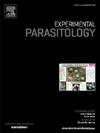吡喹酮对野生鼠源曼氏血吸虫实验感染小鼠遗传多样性的影响。
IF 1.6
4区 医学
Q3 PARASITOLOGY
引用次数: 0
摘要
吡喹酮(PZQ)目前是世界卫生组织(WHO)推荐用于治疗血吸虫病的唯一药物,这引起了人们对潜在耐药性的担忧。频繁使用PZQ可能会降低曼氏血吸虫的遗传多样性,影响其适应性和生存。本研究的目的是通过从自然感染的啮齿动物中分离的野生菌株进行实验感染,测试吡喹酮治疗和种群瓶颈对曼氏链球菌遗传多样性的影响。实验用外交种小鼠感染120尾尾蚴,暴露后50、51、52天分别给予两种不同剂量的PZQ (3× 150 mg/kg和3× 300 mg/kg), 15天后尸检。微卫星和MT-CO1作为分子标记。300 mg/kg PZQ处理后,虫载减少85.5% (p = 0.04),其中雄虫的效果更明显。MT-CO1分析鉴定出两种单倍型,其多态性位点不同,其中一种单倍型代表84.2%的种群。MT-CO1的遗传分化程度低。所有7个微卫星位点均表现出多态性,每个位点有3 - 7个等位基因。吡喹酮治疗导致群体瓶颈,降低了IT150 (RST= 0.14043, p = 0.000)和IT300 (RST= 0.13610, p = 0.005)剂量组的遗传变异性,消除了低初始频率的等位基因。我们的结论是,微卫星标记显示出遗传分化和稀有等位基因的消除,证实了PZQ处理导致的遗传瓶颈效应。本文章由计算机程序翻译,如有差异,请以英文原文为准。

Praziquantel effect on genetic diversity of wild rodent-derived Schistosoma mansoni in experimentally infected mice
Praziquantel (PZQ) is currently the only drug recommended by the World Health Organization (WHO) for treating schistosomiasis, raising concerns about potential resistance. Frequent use of PZQ may reduce the genetic diversity of Schistosoma mansoni, affecting its adaptability and survival. The objective of this study was to test the impact of Praziquantel treatment and population bottlenecks on the genetic diversity of S. mansoni by experimental infection using a wild strain isolated from naturally infected rodents. Experimental infections were conducted in outbred mice, which were infected with 120 cercariae, and treated with two different doses of PZQ (3 × 150 mg/kg and 3 × 300 mg/kg) at 50, 51, and 52 days post-exposure, and necropsied 15 days later. Microsatellites and MT-CO1 were used as molecular markers. An 85.5 % reduction in parasite load (p = 0.04) was observed after 300 mg/kg PZQ treatment, with greater efficacy in male worms. MT-CO1 analysis identified two haplotypes differing by one polymorphic site, with one haplotype representing 84.2 % of the population. Low genetic differentiation was observed for MT-CO1. All seven microsatellite loci studied exhibited polymorphisms, with 3–7 alleles per locus. Praziquantel treatment caused population bottleneck, reduced genetic variability in both dosage groups: IT150 (RST = 0.14043, p = 0.000) and IT300 (RST = 0.13610, p = 0.005), and eliminated alleles with low initial frequencies. We concluded that microsatellite markers showed genetic differentiation with elimination of rare alleles, confirming the genetic bottleneck effect due to treatment with PZQ.
求助全文
通过发布文献求助,成功后即可免费获取论文全文。
去求助
来源期刊

Experimental parasitology
医学-寄生虫学
CiteScore
3.10
自引率
4.80%
发文量
160
审稿时长
3 months
期刊介绍:
Experimental Parasitology emphasizes modern approaches to parasitology, including molecular biology and immunology. The journal features original research papers on the physiological, metabolic, immunologic, biochemical, nutritional, and chemotherapeutic aspects of parasites and host-parasite relationships.
 求助内容:
求助内容: 应助结果提醒方式:
应助结果提醒方式:


